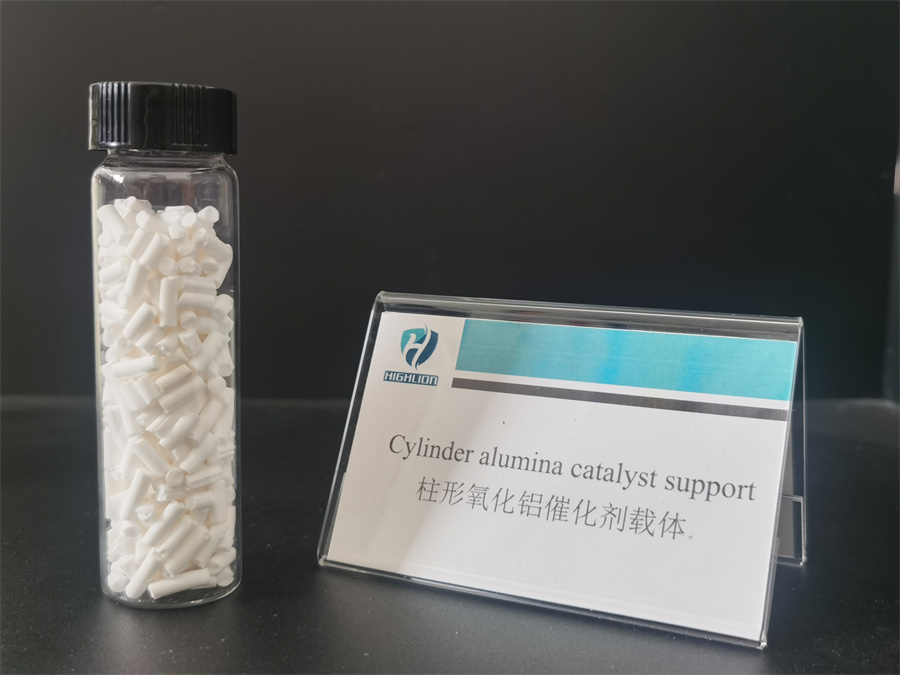Cylinderical shape alumina catalyst support

Cylindrical alumina catalyst supports are one of the most widely used carrier forms in industrial catalysis, favored for their uniform geometry, excellent mass transfer properties, and high mechanical strength, making them the preferred choice for fixed-bed reactors.
1. Basic Physical Properties
– Diameter: Typically 1–6 mm (e.g., 1.6 mm, 3 mm, 4 mm); miniaturized versions can reach 0.5 mm (for microreactors).
– Aspect ratio: Usually 1:1 to 3:1 (e.g., 3 mm × 3 mm or 3 mm × 6 mm); excessive length may increase bed pressure drop.
– Bulk density: 0.6–1.2 g/cm³, affecting reactor loading capacity.
– Smooth surface type: Reduces airflow resistance, suitable for high-velocity reactions (e.g., methane steam reforming).
– Rough porous type: Enhances anchoring sites for active components (e.g., hydrogenation catalysts).
2. Chemical and Structural Characteristics
– Crystalline Phase Composition**
| Phase | Stability Range | Surface Area (m²/g) | Typical Applications |
|————|—————–|———————|——————————-|
| γ-Al₂O₃ | 400–800°C | 150–300 | Hydrodesulfurization, VOCs purification |
| θ-Al₂O₃ | 800–1000°C | 50–120 | High-temperature combustion catalysis |
| α-Al₂O₃ | >1100°C | <10 | Ultra-high-temperature reactions (e.g., ammonia decomposition) |
- Pore Structure Parameters**
- Bimodal pore distribution design:
- Macropores (50–200 nm): Facilitate mass transfer.
- Mesopores (2–50 nm): Provide active sites.
- Trade-off between surface area and pore size:
- High surface area (>200 m²/g) preferred for noble metal loading.
– Large pores (>10 nm) suitable for heavy oil macromolecular reactions.
3. Manufacturing Process
– Key Process Flowchart:
Pseudoboehmite → Peptization (with nitric acid) → Mixing (+ pore-forming agents) → Extrusion → Drying → Calcination (500–1200°C)
– Extrusion Techniques:
– Mold design: Controls extrusion speed and pressure to prevent structural deformation.
– Plasticity adjustment: Binders (e.g., guar gum) ensure green body strength.
– Calcination Protocol:
– Ramped heating (e.g., 2°C/min) to prevent cracking.
– Nitrogen-protected calcination reduces surface hydroxyl density.
4. Typical Industrial Applications
– Application Scenario Comparison Table:
| Industry | Reaction Type | Support Requirements | Representative Catalysts |
|——————|————————-|————————————|——————————–|
| Petroleum refining | Hydrodesulfurization (HDS) | High mesoporosity, controlled acidity | CoMo/Al₂O₃ |
5. Selection and Usage Guidelines
– Key Selection Criteria:
1. Reaction kinetics: Fast reactions require smaller pellets (1–2 mm); slow reactions allow larger sizes.
2. Process conditions: High-pressure reactions need >50 N/cm crush strength.
3. Cost control: Noble metal catalysts demand high-purity supports (Na₂O <0.1%).
- Loading Specifications:
- Bed aspect ratio ≤10:1 to prevent channeling.
- Vibratory loading ensures <5% bulk density variation.

